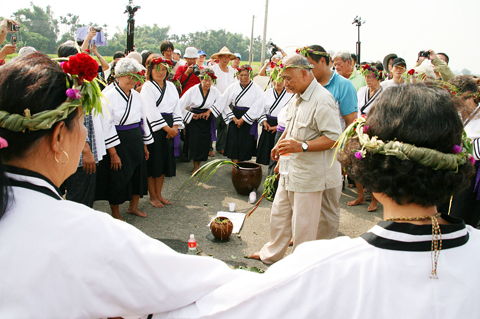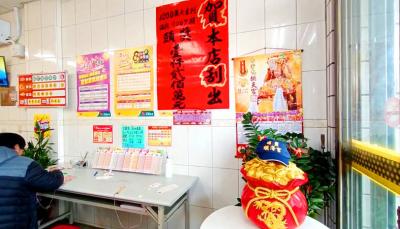Donghe Village (東河) in Dongshan Township (東山), Tainan County, looks almost the same as any other rural village in Taiwan. Walk into one of its temples, however, and they may seem surprisingly empty.
Six village temples stand empty apart from ceramic jars and vases filled with water and branches. The water-filled vases indicate that this is a Siraya village.
Temples in a village of the Siraya Aboriginal tribe are not just places of worship, but also meeting places. The temples are known as kuwa in Siraya, or konkai (公界 or 公廨) in Hoklo (also known as Taiwanese).

PHOTO: LOA IOK-SIN, TAIPEI TIMES
The Siraya are one of the pingpu (平埔), or “plains,” Aboriginal tribes that once inhabited large swathes of Taiwan’s coastal regions.
Over the past few centuries, the pingpu tribes gradually disappeared as they assimilated with the dominant Han culture and adopted the Hoklo language.
The Siraya in Tainan, as well as Siaolin Village (小林) in Kaohsiung County’s Jiasian Township (甲仙), are among the few communities that keep some Siraya traditions alive.

PHOTO: LOA IOK-SIN, TAIPEI TIMES
“We believe that we can communicate with the arit — ancestral spirits — through water, and that the forces of the arit are contained in water,” said Tuan Hung-kun (段洪坤), a researcher on Siraya culture and history and the convener of the Alliance of Siraya Communities.
“Some people say that we worship the jars, but that’s not correct. We only use the jars to hold water,” he said.
There are six konkai in Donghe: the Grand Konkai is dedicated to Anzu (案祖), the supreme spirit in Siraya culture, and two arit, while the other five konkai are spread out along the outer rim of the village, each dedicated to an arit that protects the village from evil spirits.
On the night of Oct. 21, villagers poured into the Grand Konkai to take part in the village’s biggest annual event, the Arit Ritual.
“The annual Arit Ritual is held to express our appreciation for the arit’s blessing for the year, and to ask the arit to bless us for the coming year,” Tuan said. “In the past, there were festivities all day and then religious activities after nightfall. Today only the religious part has been retained.”
Long before the ritual began at 11pm, villagers began arriving at the Grand Konkai to pray to the arit.
They brought offerings of pork, chicken, fish, small cakes made of rice called ban (粄), rice wine, betel nuts and the “five gifts” in red envelopes.
“The [five] gifts are iron from a plough, mung beans, rice grains, nails and coins. We put them in red envelopes and present them [to the arit] to ask for a good harvest, newborn children and prosperity in the coming year,” Lee Chu-lung (李朱龍), a village elder, told visitors outside the Grand Konkai.
“When you present sacrifices to the arit, the head of the chicken and the thicker part of a portion of pork must face the arit, but with the fish, it’s the tail that must face the arit,” Lee said.
No one knows why this is, he said, adding that it was a tradition handed down over thousands of years.
After arranging their offerings, villagers placed betel nuts on a small table in front of the arit jar, prayed, took a sip of rice wine and spit it over the jar.
Each villager then threw the two halves of a betel nut to the ground. If one half lands facing up and the other facing down, it means the spirit is happy; if not, the villagers may repeat the rite or consult the priest about why the spirit is not pleased.
“Our arit ritual is less influenced by Han culture, so we don’t burn incense or ghost money — there are other Siraya villages that have adopted such practices,” Lee said.
Those who prayed for something specific at the previous year’s Arit Ritual were back this year with whole pigs and other sacrifices as well as the five gifts to show their appreciation.
During the ritual, the priest chanted a spell to summon the ancestral spirit. Under his guidance, villagers who brought pigs arranged them in front of the Grand Konkai and covered them with white cloth.
“We do that because the arit likes everything neat and clean. It’s also a signal to other spirits who may be around that the pigs have already been dedicated to the arit and they may not touch them,” Siraya priest Chang Ming-hai (張明海) said.
Those who brought pigs then dripped rice wine into five goblets arranged in front of each pig, and repeated the action five times, with 20 minute intervals.
“Five” is an auspicious number in the Siraya culture, Tuan said.
It was well past 1:30am when the wine ritual ended, but there was more to come.
After seeking the arit’s approval, the pigs were removed to make way for qianqu (牽曲), the singing of ancient Siraya songs.
Around 20 women held hands in a circle as the priest placed jars with water at the center.
He invited ancestral spirits into the circle and the women began slowly to dance and sing.
“They’re singing two things: One is a song taught [to the tribe] by the arit to pray for rain after the Siraya suffered a severe drought a long, long time ago, so they sing it to remember that,” Tuan said. “They also sing another song to thank the arit for blessings over the past year.”
There’s no rule for how long the dance should last; that depends on when the ancestral spirit is satisfied.
“We ask the ancestral spirit whether it is pleased by throwing down a halved betel nut,” Tuan said. “One year the dance continued until 5am and we were all exhausted by the time it finished.”
This year the dancing lasted until 3am and the villagers were able to go home relatively early — but not to rest.
“Don’t think that’s the end of it. Those who brought whole pigs must cook the pig’s organs and head when they get home and bring the cooked pork back after dawn and before noon to finish their ritual of thanksgiving,” he said.
While the annual Arit Ritual ends with qianqu in most Siraya communities, in this village, a ritual called haohai (哮海) follows the next afternoon.
Like qianqu, haohai involves dancing in a circle and singing, but the priest performs another ritual, which lasts about an hour.
Haohai is Hoklo and could mean either remembering an incident at sea or remembering a person named A-hai.
“There are two legends on the origin of the ritual and we’re not sure which is true,” Tuan said.
One has it that the first of the Siraya ran into a storm while traveling at sea. When they finally reached shore on Taiwan, seven people were missing, and the haohai is a rite to remember them.
Another legend has it that when the Siraya arrived in the region, a man named A-hai helped them settle down, and the haohai is a ritual of thanks.
“Some say the Siraya have died out,” Tuan said. “They say we are an extinct tribe and have lost our culture.”
“Well, the fact that we still hold our nighttime Arit Ritual each year proves we are flourishing,” he said.
The Siraya hope the Arit Ritual and other traditions will never die, Tuan said. As for traditions and language already lost, Tuan said he hopes research can help the tribe explore its roots.

A Vietnamese migrant worker on Thursday won the NT$12 million (US$383,590) jackpot on a scratch-off lottery ticket she bought from a lottery shop in Changhua County’s Puyan Township (埔鹽), Taiwan Lottery Co said yesterday. The lottery winner, who is in her 30s and married, said she would continue to work in Taiwan and send her winnings to her family in Vietnam to improve their life. More Taiwanese and migrant workers have flocked to the lottery shop on Sec 2 of Jhangshuei Road (彰水路) to share in the luck. The shop owner, surnamed Chen (陳), said that his shop has been open for just

Global bodies should stop excluding Taiwan for political reasons, President William Lai (賴清德) told Pope Francis in a letter, adding that he agrees war has no winners. The Vatican is one of only 12 countries to retain formal diplomatic ties with Taiwan, and Taipei has watched with concern efforts by Beijing and the Holy See to improve ties. In October, the Vatican and China extended an accord on the appointment of Catholic bishops in China for four years, pointing to a new level of trust between the two parties. Lai, writing to the pope in response to the pontiff’s message on Jan. 1’s

TAKE BREAKS: A woman developed cystitis by refusing to get up to use the bathroom while playing mahjong for fear of disturbing her winning streak, a doctor said People should stand up and move around often while traveling or playing mahjong during the Lunar New Year holiday, as prolonged sitting can lead to cystitis or hemorrhoids, doctors said. Yuan’s General Hospital urologist Lee Tsung-hsi (李宗熹) said that he treated a 63-year-old woman surnamed Chao (趙) who had been sitting motionless and holding off going to the bathroom, increasing her risk of bladder infection. Chao would drink beverages and not urinate for several hours while playing mahjong with friends and family, especially when she was on a winning streak, afraid that using the bathroom would ruin her luck, he said. She had

MUST REMAIN FREE: A Chinese takeover of Taiwan would lead to a global conflict, and if the nation blows up, the world’s factories would fall in a week, a minister said Taiwan is like Prague in 1938 facing Adolf Hitler; only if Taiwan remains free and democratic would the world be safe, Deputy Minister of Foreign Affairs Francois Wu (吳志中) said in an interview with Italian newspaper Corriere della Sera. The ministry on Saturday said Corriere della Sera is one of Italy’s oldest and most read newspapers, frequently covers European economic and political issues, and that Wu agreed to an interview with the paper’s senior political analyst Massimo Franco in Taipei on Jan. 3. The interview was published on Jan. 26 with the title “Taiwan like Prague in 1938 with Hitler,” the ministry